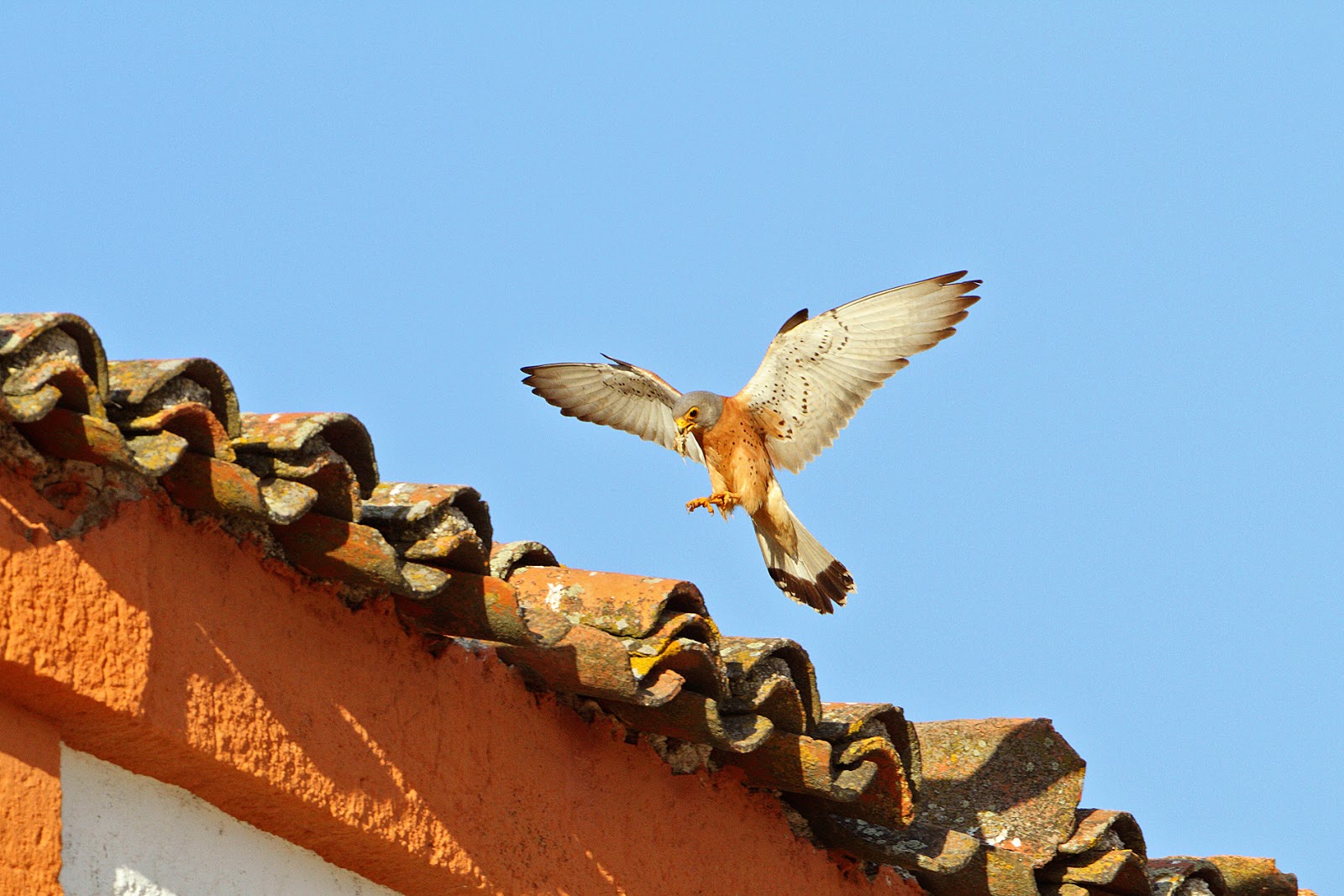A festival for our urban falcons
 |
| Male Lesser Kestrel (photo by John Hawkins) |
We were taking part in Trujillo's first Lesser Kestrel Festival, a celebration of these small colonial falcons (called locally Micales) that can be seen at the moment almost everytime one looks up, anywhere over the town. On the Thursday it was inaugurated by Trujillo's mayor, accompanied by senior representatives from the Extremadura Environment and Tourism teams. The large meeting room had a big contingent of local school children, many of whom had taken part in a Lesser Kestrel drawing competition, as well as the local photographer who had won the photo context.They were entertained by a Lesser Kestrel Rap, devised by Pepe Antolín who heads the ground-breaking conservation project in another Extremeñan town famous for its Lesser Kestrels: Almendralejo. His organisation, DEMA, works on environmental education as well as installing their specially-designed nestboxes for the species. Trial and error has resulted in the current model, with obstacles to avoid the entry of predators, drainage to prevent flooding in summer thunderstorms and ventilation to reduce over-heating. The biggest colony in Extremadura in a single building, in the largest church in Almendralejo can boast over 80 pairs some years, almost all of which are now using nestboxes.They have a successful captive-breeding programme, based on birds that were brought in abandoned or injured, which has been used to establish, or re-establish, colonies elsewhere in Spain, as well as in France and Bulgaria.
Trujillo and Cáceres are the towns with the largest numbers of Lesser Kestrel in Extremadura, each with over a hundred pairs. They are among 18 towns and villages in the region with the European-wide designation of Special Protection Areas (SPAs), specifically because of their Lesser Kestrel colonies. Extremadura boasted the very first urban SPAs in the whole of Europe.
 |
| Urban birding in the Main Square of Trujillo (Claudia Kelsey) |
Standing in the main square, with groups of local children and adults taking part in excursions during the Festival (some of the children enjoyed the urban birding so much that they turned up on successive days, morning and evening to take part!), we feasted on one spectacle after another. Whilst the food-carrying Lesser Kestrels were clearly the main attraction, there was much else to see as well. Young White Storks were making short hops above their nests, the light breeze giving enough lift below their open wings to suspend them for a few seconds - their first chance to feel being airbourne. Packs of restless swifts zoomed screaming around us, hurtling madly in pitches and turns against the buildings and down the narrow streets. A Black Redstart sang from a television aerial, whilst a Booted Eagle made several appearances, causing angry rebuttals from gangs of Jackdaws.
ç
 |
| Talking about House Martins and other urban birds (Claudia Kelsey) |
We took the groups around the town to watch the four species of breeding hirundine in the town, making their nests from the goblets of sun-baked mud: the evolution of the brick long before human house-building (did the early Mesopotamians watch and then copy the techniques of swallows?). And we ended up at the Bull Ring, the building with the largest number of Lesser Kestrel nests, watching the waves of adults coming in the nearby plains with the food for the young. Barely did the adults pause to stop on the roof, so urgent their task, landing and scrambling in under a loose tile to their chicks. As we stood there, from below such a tile a movement was spotted. And there at the entrance sat a white downy chick, perhaps seeing the sunshine for the first time, with just the start of the russet barred flight feathers coming into view. It was the first nestling I had seen this year and it stayed at its porch long enough for all of the group to see. In a couple of months, that youngster will head off for Senegal, a journey it will do in a matter of days, to join other Lesser Kestrels in vast winter roosts. Many of the species we were seeing in town are summer visitors and all of them, in one way or another, using buildings as nest sites, spreading out to feed in the surrounding countryside, or indeed from the skies above us.
 |
| Looking at the Lesser Kestrel chick at the Bull Ring Trujillo (Claudia Kelsey) |



Comments